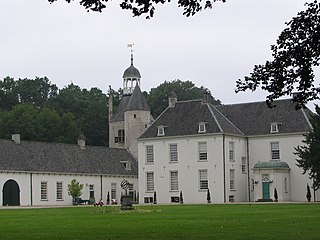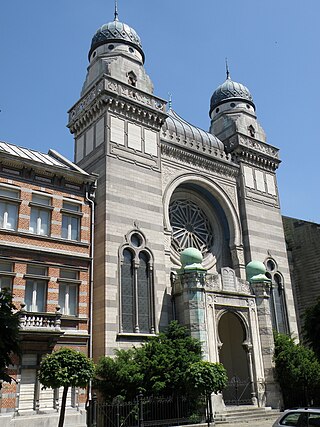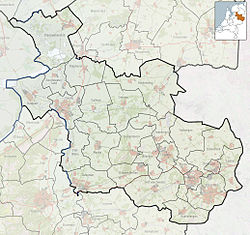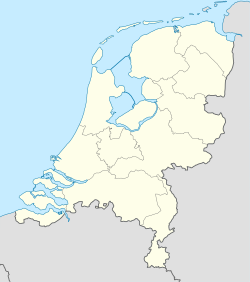
Enschede is a city and municipality in the province of Overijssel and the Twente region of the eastern Netherlands. The east of the urban area reaches the border of the German city of Gronau.

Hellendoorn is a municipality and town in the middle of the Dutch province of Overijssel. As of 2019, the municipality had a population of 35,808.

Hof van Twente is a municipality in the region Twente, in the province Overijssel in the eastern Netherlands. The municipality was established January 1, 2001, as the result of the merger of the municipalities of Diepenheim, Goor, Markelo, Ambt Delden, and Stad Delden.

Terborg is a small city in the Dutch province of Gelderland, in the Achterhoek region in the east of the Netherlands. It is located in the municipality of Oude IJsselstreek. The city lies about 7 km southeast of Doetinchem. The population is about 4600 inhabitants.

Markelo is a village in the Dutch province of Overijssel. It is located in the municipality of Hof van Twente, about 20 km (12 mi) west of Hengelo and 20 km (12 mi) south-west of Almelo.

Nijverdal is a town of approximately 25,000 inhabitants in the Dutch province of Overijssel. It is the commercial centre and largest town within the municipality Hellendoorn.

Diepenheim is a small city in the Dutch province of Overijssel. It is located in the municipality of Hof van Twente, about 5 km southwest of Goor. Diepenheim was a separate municipality until 2001, when it became a part of Hof van Twente.

The history of the Jews in the Netherlands largely dates to the late 16th century and 17th century, when Sephardic Jews from Portugal and Spain began to settle in Amsterdam and a few other Dutch cities, because the Netherlands was an unusual center of religious tolerance. Since Portuguese Jews had not lived under rabbinic authority for decades, the first generation of those embracing their ancestral religion had to be formally instructed in Jewish belief and practice. This contrasts with Ashkenazi Jews from central Europe, who, although persecuted, lived in organized communities. Seventeenth-century Amsterdam was referred to as the "Dutch Jerusalem" for its importance as a center of Jewish life. In the mid 17th century, Ashkenazi Jews from central and eastern Europe migrated. Both groups migrated for reasons of religious liberty, to escape persecution, now able to live openly as Jews in separate organized, autonomous Jewish communities under rabbinic authority. They were also drawn by the economic opportunities in the Netherlands, a major hub in world trade.
The Nederlands-Israëlitisch Kerkgenootschap (NIK) is the umbrella organisation for most Ashkenazi Jewish communities in the Netherlands, and is Orthodox in nature, while to be described as traditional in outlook. The expression Orthodox, is for the Dutch situation at least, of a later date than the existence of the congregations that make up the NIK and the NIK itself. The Rabbi of the NIK is Rabbi Dr. Raphael Evers. In total, the NIK has some 20 rabbis actively working in 18 congregations throughout the country, serving some 5,000 Jews.

The Nederlands Verbond voor Progressief Jodendom is the umbrella organisation for Progressive Jews in the Netherlands, and is affiliated to the World Union for Progressive Judaism. It was founded in 1931.

The Hollandse Synagoge, officially the Synagogue Shomré Hadas, and also known as the Bouwmeester Synagoge, is an Orthodox Jewish congregation and synagogue, located on Bouwmeestersstraat 7, in Antwerp, Belgium. Whilst the first Jews arrived in Antwerp in the 14th century, the congregation was not officially established until 1816. Descendants of Jews who came to Antwerp from the Netherlands in the early 19th century, built the synagogue in 1893 and it was the first large synagogue in Antwerp.

The History of the Jews in Amsterdam focuses on the historical center of the Dutch Jewish community, comprising both Portuguese Jews originally from both Spain and Portugal and Ashkenazi Jews, originally from central Europe. The two separate groups have had a continuing presence since the seventeenth century. Amsterdam has been called a Jerusalem of the West and the "Dutch Jerusalem". The Holocaust in the Netherlands devastated the Jewish community, with the Nazis murdering some 75% of the approximately 80,000 Jews at time present in Amsterdam, but the community has managed to rebuild a vibrant and living Jewish life for its approximately 15,000 present members.

Thomas Ainsworth (1795–1841) was an Englishman and the founding father of Nijverdal, a small town in the Netherlands, during the 19th century. He laid the basis for the Royal Steam Weaving Mill (KSW) in Nijverdal in 1836 that is still operating today under the name Koninklijke Ten Cate NV.

Abraham Asscher was a Dutch Jewish businessman from Amsterdam, a politician, and a leader of his community who attained notoriety for his role during the German occupation of the Netherlands (1940–1945).
The Jodenbuurt is a neighbourhood of Amsterdam, Netherlands. For centuries before World War II, it was the center of the Dutch Jews of Amsterdam — hence, its name. It is best known as the birthplace of Baruch Spinoza, the home of Rembrandt, and the Jewish ghetto of Nazi occupation of the Netherlands.

The Great Synagogue of Deventer is a former Jewish congregation and synagogue, located at Golstraat 23, in the city of Deventer, in the Overijssel region of The Netherlands. Designed by J. A. Mulock Houwer in a mix of the Renaissance Revival and Moorish Revival styles, the synagogue was completed in 1892.
The Dutch Israelite Religious Community of The Hague is the Ashkenazi Orthodox Jewish community in The Hague and is a member of the Nederlands-Israëlitisch Kerkgenootschap (NIK).

Estella Dorothea Salomea Hijmans-Hertzveld was a Dutch poet, translator, and activist. From a young age, her poems, mainly on Biblical and historical themes, appeared regularly in respectable literary journals. Frequently, her work also addressed contemporary social issues, including the abolition of slavery, Jewish emancipation, and opposition to war. A collection of her best-known poems, entitled Gedichten ('Poems'), was published several weeks before her death in 1881.

The Jewish cemetery in Hoorn can refer to the original Jewish cemetery on the outskirts of the Dutch city of Hoorn, or to a separate section of today's public cemetery. That Jewish section was opened in 1968, after the old Jewish cemetery was cleared for road construction.

Herman Salomonson, also known as Melis Stoke, was a Dutch journalist, writer, and poet of Jewish heritage. In 1940 he was arrested by the German occupiers of the Netherlands and murdered in 1942.























